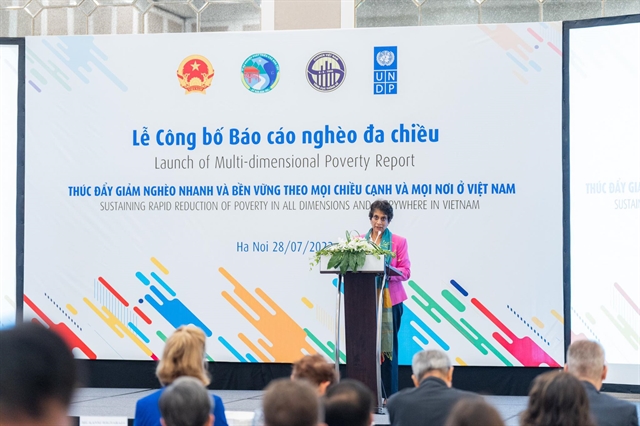 Society
Society

 |
UN Assistant Secretary-General and UNDP Regional Director for Asia and the Pacific Kanni Wignaraja speaks at the meeting in Hà Nội. Photo courtesy of UNDP in Việt Nam
HÀ NỘI – According to the latest Multi-Dimensional Poverty (MDP) Report, poverty rates in Việt Nam are continuing to fall and the country is becoming a model for other nations to follow, though more needs to be done to ensure that ethnic minority groups aren't left behind.
According to the MDP Report 2021 which was launched in Hà Nội yesterday, Việt Nam has seen progress in multi-dimensional poverty reduction, thanks to the rapid expansion of productive employment; improvement of social services; and expansion of the social protection systems. However, vulnerabilities and disparities represented significant challenges.
Statistics from MOLISA show that the national poverty rate has fallen from 58.1 per cent in 1993 to 2.75 per cent in 2020 and 2.23 per cent in 2021. Việt Nam has completed the Millennium Development Goals of the United Nations on hunger eradication and poverty reduction.
Although the overall poverty rate dropped nationally, the rate is still high among ethnic minorities. More specifically, while digital transformation in the education sector has increased, inequality in access to technology and equipment was still a challenge.
The digital divide was more pronounced during COVID-19. Access to health services improved, but disparities remained, especially between national and district/community level health service providers.
Deputy Minister of Labour, Invalids and Social Affairs (MOLISA) Nguyễn Bá Hoan said: “The report provides detailed analysis of productive jobs, social services and social security for people.”
"It is considered an effective solution to maintain the achievement of multi-dimensional poverty reduction and reform the social security system in Việt Nam.”
Chairman of the Ethnic Committee Hầu A Lềnh said that Việt Nam’s MDP reports over years, supported by UNDP, show that the national multidimensional poverty rate has decreased on a large scale. However, the number of poor households is still mainly concentrated among the ethnic minorities and is especially among groups such as the H'mong, Dao and Khmer.
On her official visit to Việt Nam, UN Assistant Secretary-General and UNDP Regional Director for Asia and the Pacific Kanni Wignaraja attended the meeting.
“I would like to congratulate Việt Nam for addressing something that many other countries have yet to get on track with. We must recognise the remarkable achievements, the direction forward and the progress made in the last couple of decades,” said Wignaraja.
“One of the best ways to really, deeply make a dent, and even beyond the dent to move things forward is the creation of more and more productive jobs, but without macro-economic stability, without the kind of trade integration, without public and private sector investment in infrastructure, this cannot happen. ”
She also said that in Việt Nam, domestic firms would need to really take on much greener technology if they are to compete at the same level in the regional and global market.
The report was jointly produced by the Ministry of Labour, Invalids and Social Affairs (MOLISA), Committee for Ethnic Affairs (CEMA), General Statistics Office, Ministry of Planning and Investment (MPI), with the support from the Australian Government Department of Foreign Affairs and Trade (DFAT), and technical cooperation from the Centre for Analysis and Forecasting under the Viet Nam Academy for Social Science (CAF/VASS).
On September 15, 2015, the Prime Minister signed Decision No 1614/QD-TTg approving the Master Project of "Transforming the poverty measurement approach from single-dimensional to multi-dimensional for the period 2016- 2020.” VNS




